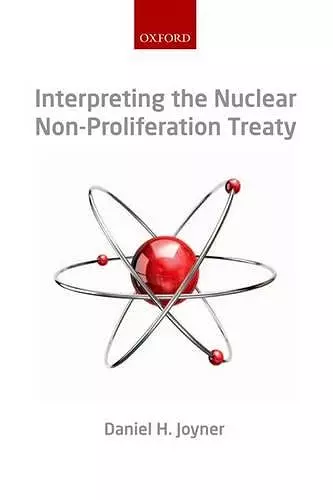Interpreting the Nuclear Non-Proliferation Treaty
Format:Hardback
Publisher:Oxford University Press
Published:26th May '11
Currently unavailable, and unfortunately no date known when it will be back
This hardback is available in another edition too:
- Paperback£43.99(9780199669943)

The 1968 Nuclear Non-proliferation Treaty has proven the most complicated and controversial of all arms control treaties, both in principle and in practice. Statements of nuclear-weapon States from the Cold War to the present, led by the United States, show a disproportionate prioritization of the non-proliferation pillar of the Treaty, and an unwarranted underprioritization of the civilian energy development and disarmament pillars of the treaty. This book argues that the way in which nuclear-weapon States have interpreted the Treaty has laid the legal foundation for a number of policies related to trade in civilian nuclear energy technologies and nuclear weapons disarmament. These policies circumscribe the rights of non-nuclear-weapon States under Article IV of the Treaty by imposing conditions on the supply of civilian nuclear technologies. They also provide for the renewal and maintaintenance, and in some cases further development of the nuclear weapons arsenals of nuclear-weapon States. The book provides a legal analysis of this trend in treaty interpretation by nuclear-weapon States and the policies for which it has provided legal justification. It argues, through a close and systematic examination of the Treaty by reference to the rules of treaty interpretation found in the 1969 Vienna Convention on the Law of Treaties, that this disproportionate prioritization of the non-proliferation pillar of the Treaty leads to erroneous legal interpretations in light of the original balance of principles underlying the Treaty, prejudicing the legitimate legal interests of non-nuclear-weapon States.
An understanding of the unsettled controversies surrounding
interpretation of the NPT... absolutely requires the reading of Joyners challenging work. * Pierre-Emmanuel Dupont, Leiden Journal of International Law.Surabhi Ranganathan, BYIL *
This study is a remarkable one and is greatly welcomed at an important juncture and after a successful NPT Review Conference in 2010. Daniel H. Joyner has relied on solid grounds in interpreting the Treaty, not relying entirely on statements made by certain officials and personalities involved in negotiating the Treaty. Since my book was published more than 30 years ago, it is a great source of comfort to find such a new and remarkable study that greatly enhances our understanding of the NPT and which can be considered as an inescapable companion to my study of the NPT negotiations. This new study should be a required reading to any one who would wish to deal with nonproliferation * Ambassador Mohamed Shaker, President of the Egyptian Council for Foreign Affairs, Author of The Nuclear Nonproliferation Treaty: Origin and Implementation 1959-1979 (1980) *
Interpreting the Nuclear Non-proliferation Treaty is an excellent book that sets out a clear thesis and then evidences its claims with significant detail. * James A Green, American Journal of International Law *
...readers seeking policy arguments that are at variance with the traditional view will find a wealth of material in this book. * Norman A. Wulf,Arms Control Today *
With meticulous scholarship and brilliant argumentation, Joyner methodically demolishes the assertions that the nonproliferation pillar is dominant and that the peaceful uses and disarmament pillars are somehow lesser...a superb contribution to this important discussion. * Thomas Graham Jr, Nonproliferation Review *
It is time now to revive international cooperation to increase concensus on NPT interpretation, foster its implementation in all its aspects, and effectively ensure respect for its rules. Joyner's book is an excellent contribution to any such endeavour. * Dieter Fleck, European Journal of International Law *
To sum up, we hold that an understanding of the unsettled controversies surrounding interpretation of the NPT, and more generally of the balance between non-proliferation concerns and peaceful nuclear energy ambitionsthat the treaty's 'grand bargain' was supposed to achieve, absolutely requires the reading of Joyner's challenging work. * Pierre-Emmanuel Dupont, Leiden Journal of International Law *
Overall, the book is a very welcome addition to discussions about the NPT specifically and nuclear weapons law generally. In tracing the statements and policies of the States Parties to the treaty over the twelve-year period from 1998-2010, Professor Joyner has made an important contribution. * Treasa Dunworth, Netherlands International Law Review *
ISBN: 9780199227358
Dimensions: 237mm x 162mm x 19mm
Weight: 468g
200 pages